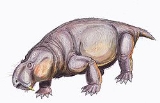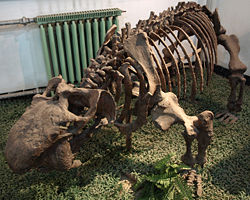
Sinokannemeyeria
Encyclopedia

Dicynodont
Dicynodontia is a taxon of anomodont therapsids or mammal-like reptiles. Dicynodonts were small to large herbivorous animals with two tusks, hence their name, which means 'two dog tooth'...
with downward-pointing tusks that grew from bulbous projections on its upper jaw. The muscle attachment sites on the back of the skull were quite small, which suggestd that Sinokannemeyeria did not have powerful skull muscles for shearing plants, unlike other dicynodonts. Most dicynodont
Dicynodont
Dicynodontia is a taxon of anomodont therapsids or mammal-like reptiles. Dicynodonts were small to large herbivorous animals with two tusks, hence their name, which means 'two dog tooth'...
s chopped up food by sliding their lower jaw
Jaw
The jaw is any opposable articulated structure at the entrance of the mouth, typically used for grasping and manipulating food. The term jaws is also broadly applied to the whole of the structures constituting the vault of the mouth and serving to open and close it and is part of the body plan of...
s backward and forward. Sinokannemeyeria fed by tearing plant material with the front of the snout.
Sinokannemeyeria and the other kannemeyeriines descended from ancestors similar to Lystrosaurus
Lystrosaurus
Lystrosaurus was a genus of Late Permian and Early Triassic Period dicynodont therapsids, which lived around 250 million years ago in what is now Antarctica, India, and South Africa...
.

